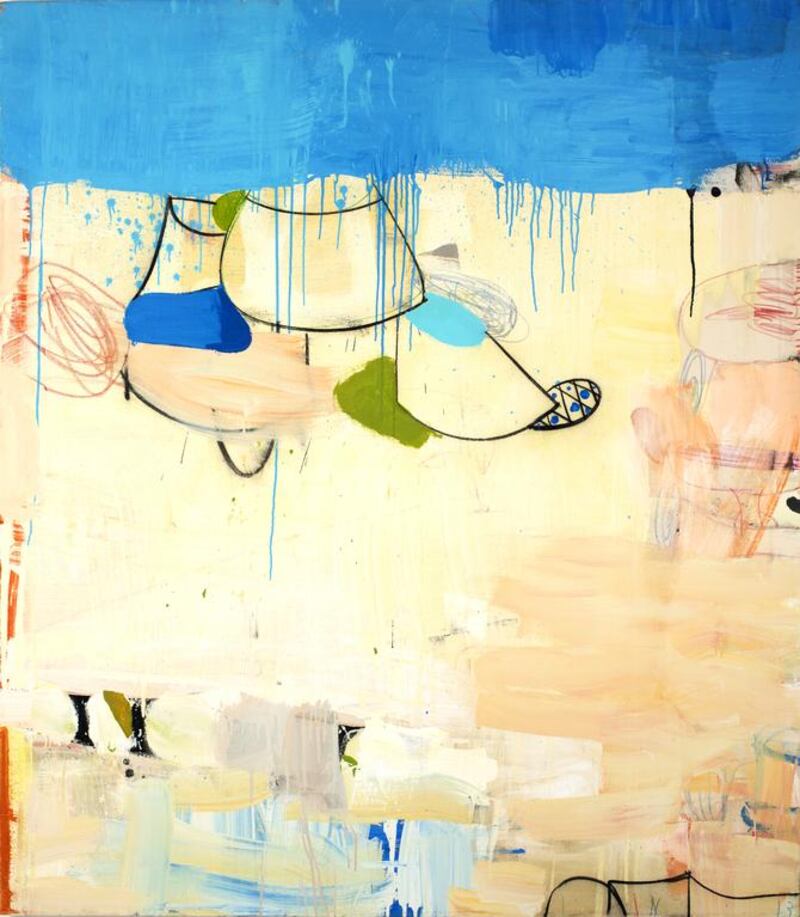If you find yourself looking at a Gary Komarin painting and wondering what exactly he is trying to depict, perhaps you will take comfort in the fact that the artist himself once said that the drive behind each piece is trying to “figure out what it is I am painting”.
The wandering canvases, mostly made up of blank spaces of pastel colours woven together with barely traceable lines and seemingly random paint drops, often contain odd shapes and forms that seem familiar yet evade definition.
Using, for the most part, thinned-out vinyl paints that dry much more quickly than regular acrylics and oils, the artist is exercising a kind of self-restraint that leads to these largely empty paintings, which are both non-narrative and non-figurative.
“Although at first look they seem simple and juvenile, they are actually the work of a highly skilled painter and the more time you spend with these works the more they pull you in deeper and deeper,” says Bashar Al Shroogi, the founder of Cuadro Fine Art Gallery, where a solo show of Komarin’s work is currently on display.
Merging painting and drawing
Komarin is an American painter who spent the beginning part of his four-decade career under the mentorship of the neo-expressionist painter Philip Guston. Guston, a contemporary of Willem de Kooning and Jackson Pollock, influenced Komarin to merge painting and drawing, hence the shapes and lines within his work.
Substantially awarded for his practice and having exhibited his works alongside artists such as Francis Bacon, Robert Motherwell and Jean-Michel Basquiat, it is fair to call Komarin an internationally acclaimed artist.
His work first appeared in Cuadro in the Dubai International Financial Centre in 2008 during their inaugural group show, but this is his first solo exhibition in the region.
“One of the things that really attracted me to Gary’s work is his plastic quality,” says Al Shroogi. “You can really feel the process of creation and as your eye learns to read the canvas you find beautiful moments that show his mastership. If you talk about a painting in terms of colour, line, form and composition, then Gary has really got it.”
According to Al Shroogi, the best way to read one of Komarin’s works is to understand its rhythm and harmony – in the same way you would appreciate a piece of music.
“When you start looking at it, you can focus on individual areas and then notice how well they lead into the next. There are elements such as bold outlines and shapes in the foreground and a very gentle, delicate interplay as these areas bring us into the background.”
Starting point
Another notable point when seeing the paintings is to understand Komarin’s practised reserve. It takes a lot of skill to know when to stop applying the paint, as well as just how much to add – and this is something that sets Komarin apart as an artist.
But before he even applies the paint, Komarin starts with a very particular process of selecting the title at random. He has a jar in his studio, nestled in the wooded hills of Roxbury, Connecticut, which he fills with jotted-down thoughts, moments, feelings, street names and other obscure details. When he wants to start a painting, he picks out one and then allows that to dictate his process.
The titles are usually mythical or whimsical, such as A Suite of Blue Sea (Lily Pond Land) or Lewis and Clark in Cream with Green and do little to aid comprehension, which, as Al Shroogi describes, is not supposed to be a finite process.
“The forms come all the way up to a point where you have almost recognised them and then they wither away again,” he says. “There is huge learning in pieces like these. We don’t see this kind of work all the time.”
Layer upon layer
Also in the show, other than the huge canvases, are some works on paper called Cakes. The series includes several small works on brown paper bags and two large pieces displayed in the gallery's windows.
The tower-like structures in the windows are painted on several bags, showing full-sized, multilayered cakes, but the forms are abstract enough to also resemble skyscrapers.
Inside the gallery, the top of the cake or building has been repeated many times in a number of smaller pieces so that the interpretation again begins to elude us and the shapes look like masks or helmets.
“These pieces show us how comfortable Gary is working in different mediums,” says Al Shroogi.
While even a square inch of one of Komarin’s works can be studied and brings forth an interpretation, Al Shroogi says that the simple joy of his work is the process of getting lost in working them out.
“You never get anywhere, you never find any resolution at the end, but the enjoyment of his work is the journey itself, the fact that you are constantly finding and seeing more in these compositions.”
• The Road to Dialoro | Gary Komarin runs until June 19 at Cuadro Fine Art Gallery, DIFC, Dubai
aseaman@thenational.ae





